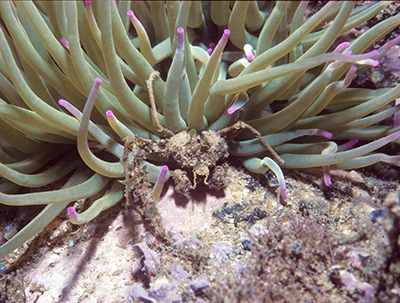My scientific investigations have focused on the evolution of reproductive strategies in animals. I conducted field research on marine and terrestrial crustaceans as well as on tropical anurans. The research focused on strategies for maximizing reproductive success, sperm competition, and investment in offspring, e.g. through intensive brood care.
See Publication List

The Spider Crab Story
This inconspicuous fellow, the male ghost crab Inachus phalangium, has a tiny brain, but when it comes to dating with its ladies, it demonstrates extraordinary memory.
In my study area near Banyuls-sur-Mer (F), the ghost crab spider crab lives under the protection of the stinging sea anemone Anemonia viridis. Adult female spider crabs remain in the same place, on the same anemone, for their entire lives and continue to lay eggs until they die. The last copulation partner before spawning is the father of the entire next brood.
A spider crab male can maximize the number of his offspring if he copulates with many females shortly before they spawn. However, these potential reproductive partners live widely scattered in a fragmented, rocky habitat and each has its own spawning cycle. This is when the large territory holders show what they are made of: They remember the exact location and spawning date of every female in their territory and arrive in time to fertilize the new clutch.
This ability is known in science as episodic memory.

The Jamaican Crabs Story
When it comes to radiation and speciation, Jamaica rivals the Galapagos at least for terrestrial crabs, snails and frogs.
Studies of the Jamaican crabs by me and my students over a 20-year period show how this came about and where it went.
3-4 million years ago, the ancestor of the Jamaican crabs became independent of salt water in the ocean, and its descendants invaded new freshwater habitats. They adapted to caves, streams and rivers, the forst underground and the canopy of rainforest trees.
Over 13 endemic species have emerged that have solved the problem of terrestrial reproduction in very different ways.
Jamaica holds the world record for endemic crab species per square kilometer.

The Bromeliad Crab Story
The Jamaican bromeliad crab, Metopaulias depressus, has unique reproductive and social behavior among crustaceans. For crabs, reproduction in a terrestrial habitat presents the greatest challenge. As a relatively recent species in this habitat, the survival of the larvae and young is crucial. The bromeliad crab has developed a set of adaptations for this.
It spends its entire life in bromeliad plants. There, in the leaf axils, it finds water and food. The mother cares for, feeds and protects the brood from predators. Young crabs stay with their mother and siblings for up to 2 years. The bromeliad crab lives in a family clan on its own bromeliad.

The Extrodinay Snail Crab
The Jamaican snail crab, Sesarma jarvisi, is another survivor in an inhospitable habitat for crabs. It has evolved incredible behavior to do so.
Although I found this hidden living species occasionally in my explorations in the rugged limestone hills, it took years before it revealed its nursery to me.
This small crab lives under rock debris in the forest underground. Permanent water is hardly available, but without water, larval and juvenile development is impossible.
However, the shells of large land snails were handy.

Crabs Conquer Land
For more than 13 years, I and my students Martina Schuh, Diethard Horst, Gernot Bäurle, Christoph Schubart and Jens Reimer have been researching various aspects of the evolution of
Jamaican Sesarminae, i.e., what I call Jamaican crabs.
The focus was on the question of when and how the colonization of land took place, i.e., the independence from a marine planktonic larval development and the colonization of limnic and terrestrial habitats and their radiation and evolutionary adaptation to the many new habitats, especially in reproduction.

The First Cave Frog
The Jamaican cave breeding frog, Eleutherodactylus cundalli, is one of 21 frogs endemic to Jamaica. During the breeding season, it penetrates deep into Limeston caves, where males emit advertise calls from small territories where mating takes place. The females lay a cluch of eggs and take care of the brood until the froglets hatch.
E. cundalli was described as the first recorded cave-breeding frog worldwide.



.jpg)






.jpg)